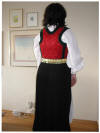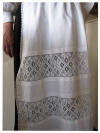Womans bunad from Fana
|
|
|
She also made her husband Arne a mans bunad from Fana.
|
|
The green lining on the bodice and the skirt means that the woman is married. The girls bunad is made with blue lining. Elins bunad was made by Husfliden in Bergen in 2000. Thank you to her husband, Vidar Holum, for taking the pictures, and sending them to me.. and, thank you to Elin for putting on the bunad again after May 17th, just for the picture-taking!
|
 A
look at the back of the bunad, click on the image to get a larger picture,
and you will see the beautiful brocade in the bodice. A
look at the back of the bunad, click on the image to get a larger picture,
and you will see the beautiful brocade in the bodice.
|
 The
bodice inset, beautiful handwork! The
bodice inset, beautiful handwork!
|
 The apron - traditional Hardanger-embroideries. |
 A closeup of the front, notice the silver belt! |
 On this picture you can see the ring on Elins finger, and the cuff links. |
 A close up on the sølje, the ring an the cuff links |
 The silver worn with this bunad is usually gold-plated. Married women may have several semi-precious stones set in the silver, and the original custom allowed only married women to wear silver that was set with green semi-precious stones. |
More about the Fana Bunad
As a festive costume for women, the Fana bunad has never been completely abandoned in this district. This costume has features from several periods, mostly from the 19th century but also from the 20th century. Its colours and design may vary, but it has always retained its special cut. Right from the beginning, it was customary to distinguish between girls’ and women’s bunads, and we try to maintain this distinction today. When women marry, the blue edge at the bottom of the pleated skirt is replaced by a green edge. Married women may wear the silver belt, and they change their headwear from a cap to a headscarf.
source: Husfliden